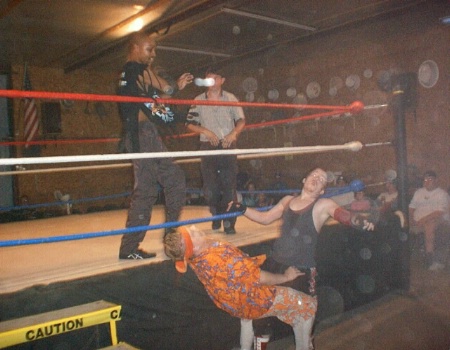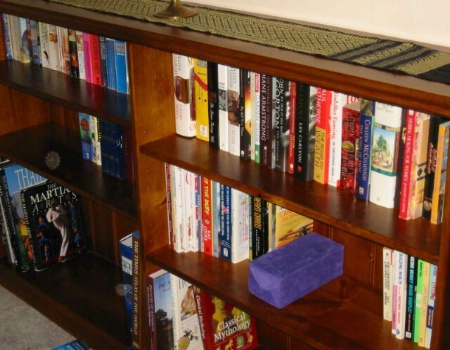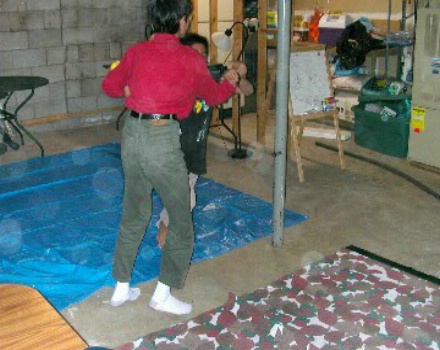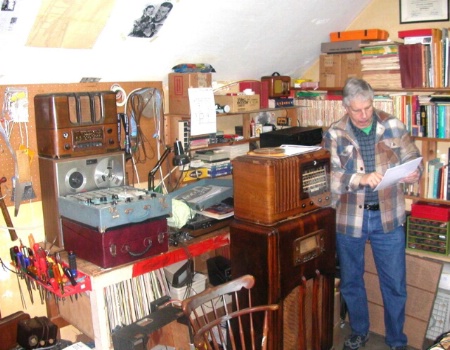
BetterPhoto Member |
|
White Spots on Photo
Can anyone explain the problem I am experiencing with my brand new kODAK digital camera. On some pictures but not all, white circles are appearing. They dont seem to be in the same place each time. I have cleaned the lens which has made no difference.
January 05, 2002
|
|
|
Glenn Theal |
|
HI, Andrew: Well, I would have suggested cleaning the lens, however, you have stated that you've done so already. The spots appear to resemble light rings. It's difficult to say what the actual cause is. It could be a faulty CCD unit within your camera. It may be dust or dirt on the internal parts of your camera that are responsible for image capture. It may also be your storage media. Unfortuanately, I can not say what it is without step-by-step testing. I would clean the entire camera. Then, I would remove the storage media and make sure that it is clean. Then, test the camera. If this doesn't work, try using a different media card. Finally, if all else fails, return the camera for a new one. Cheers,
Glenn
January 04, 2002
|
|
|
John A. Lind |
|
Andrew,
I strongly suspect the rings (spots) are caused by "aperture flare" which is light from a comparatively very bright light source (typically a small or pinpoint source) bouncing around inside inside the lens and picking up the shape of the aperture. I've seen the indentical phenomenon on film.The light source itself may or may not end up in your photograph, but would have to fall on the lens front. To some extent lens design influences susceptibility to aperture flare, however it can still occur with the most "flare resistant" lenses under conditions with high risk for it. How to prevent it?
Look for extremely bright pinpoint sources of light within view of the lens front and either move it or compose differently to eliminate it. For "off-axis" (outside the image) sources in front of a lens, the traditional method for eliminating flare is using a lens hood, or otherwise shading the lens front from the bright light falling on it. Since you're not burning film, you can experiment some with photographs containing extremely bright pinpoint light sources and some without any. If you can reliably create these spots by doing so, then you know what the phenomenon is and how to avoid it. In the first picture you posted it looks as if your flash itself may have been the culprit with its very "hot" reflection off the lower left corner of glass covering the picture in the background. Watch for mirrors, windows and glass-covered pictures or wall artwork when using a flash! Don't aim directly at them; the reflection from the flash will bounce right back into the camera. Move so they're out of the image or at least aiming at an angle to them (reflection will bounce off at an angle away from the camera). -- John
January 05, 2002
|
|
|
Jaymes R. Stuart |
|
Andrew...you've got a lemon! Any decent digital camera should handle the relatively small light sources in these two images, without spraying white dots all over the place. Take the camera, and the images, back to the dealer and ask for full credit towards a quality digital: Nikon 950, 995, Olympus C3030, C4040. Keep the faith, Jaymes
Digital Evangelist
January 08, 2002
|
|
|
Hermann Graf |
|
Your problem you is well known in digital photography (I am saying this not only to tackle the digital evangelist). You should avoid to take pictures vs. reflecting surfaces, especially when using a flash, or when they are illuminated by strong daylight. The reflections are puzzling the light meter.
January 11, 2002
|
|
|
Jeff Lowe |
|
Hermann is exactly right here. I was having the same problem with my 'Quality Digital' as was stated earlier. I starting watching and being more observant about lighting and reflective surfaces around what I was photographing, once I started doing this, the spots went away!
January 11, 2002
|
|
|
Jaymes R. Stuart |
|
I have made hundreds of digital images into dozens of light sources of all varieties and I have never seen anything like the spots in Andrew's pictures. A review of Internet digital camera forums also fails to turn up the problems Andrew is having. Random spots are not "well known in digital photography". If they were, digital cameras would be languishing in warehouses instead of flying off retailers' shelves at premium prices. Andrew should take his camera back and get one that works. We Shall Overcome...
Jaymes
Digital Evangelist
January 15, 2002
|
|
|
Jeff Lowe |
|
I don't know why it is that people like this always have to turn these types of things into debates and then get proven wrong. Here is a link to sites that discuss this topic. http://webpages.charter.net/bbiggers/DCExperiments/html/spots_.html The spots can be caused by dust in the air, misty rain AND as quoted directly from this site....."Normal reflections of the flash You will also see "spots" formed by reflection of the flash off all sorts of objects. Drops of water on swimmers, sharp metal objects or corners (such as a doorknob or the corner of a metal window blind), reflective surfaces (such as a knife or fork), polished plastic toys, moist eyes,lips and teeth; all can reflect the flash and give a very small bright highlight that looks like a "spot". In the case of all of the bright spots, they are most visible against a dark background; an underlit room, a piece of dark clothing. " This is a a discussion of a Nikon CP990 and CP995. Here is yet another site that discusses how going to digital photography INCREASES the chance of lens flare because of errant light entering the lens.....http://www.imaging-resource.com/NEWS/1007148723.html, again I quote from this site..."A press release from the folks at TrueDigitalPhoto alerted us to their new line of FlexHood lens hoods designed specifically for use with single lens reflex (SLR) digital cameras from Canon, Fuji, Kodak and Nikon. Many photographers switching from film to digital will have noticed that lens flare can be more of a problem than they're used to - and there's a fairly simple reason for that. Lens flare is caused by bright, stray light entering the lens at an angle, and reflecting off the interior glass surfaces;....."
These are two sites out of 27 pages that I found when I did a search from Google.com. Digital is good, but it's not perfect. Do your homework Jaymes, we have. You have more than one person on here that has experienced the problem and has corrected it, you say you haven't experienced it, well, you're either really lucky, or you are just too good for anyone else to be compared to, I would have to say really lucky. The whole key here is that Andrew stated "On some pictures but not all, white circles are appearing. They dont seem to be in the same place each time....." problems with the camera don't move from one place to the other, but errant outside light does! Andrew, stick with it, you'll get the hang of it.
January 15, 2002
|
|
|
Mark A. Lynch |
|
|
|
|
|

Wrestling Photo 2001 (c)M. Lynch
This is one of my less fortunate shots.
Mark A. Lynch
|
|
|
|

Wrestling Photo (c)M. Lynch 2002
This is a much better pic and spot-free too.
Mark A. Lynch
|
|
|
|
Hey Andrew I too had the same trouble with several white sots on my digital pic's after taking them indoors. I was told first try cleaning the lense with rubbing alcohol and a napkin (using a napkin because they do not leave len). Also I adjusted my light settings. On my Polaroid Digital PDC700 there are settings for fluorescent lights, lamp and others as well. After learning (properly) how to use these I don't have the white spots anymore. I hope I was helpful and if I wasn't I learned another lesson in life :)
August 03, 2002
|
|
|
John A. Lind |
|
Yes, all the photographs I've seen posted here show classic symptoms of three types of lens flare: a. Light being scattered inside a lens causing an overall loss of contrast and in the most severe cases it looks as if the image has been fogged. Indeed, this is what a "fog" filter does. Usual causes are lens elements fogged with lubricant (evaporated and condensed on lenses), severe dust on one or more lens surfaces (inside or outside the lens), or fungus growing inside the lens (looks like a white tangle web), lens group cement failure (a group is two or more elements cemented together with no air between them), or a poorly designed lens that scatters light around the inside of the lens barrel and possibly inside lens elements themselves. b. Light from a relatively small but very bright light source in the image that severely fogs it for a large region around the light source. All lenses will do this to some extent, but with good ones it will be very minimal and it will not obscure outline details of the light source. Cure is usually a better lens that is more flare resistant, or not shooting into this type of situation. c. Light from a very bright light source in or out of the image, but still illuminating the front of the lens. Light bounces around inside the lens, usually between lens surfaces and possibly the side of the lens barrel. It produces one or more hot spots in the shape of the lens aperture on the image, sometimes picking up the colors of the lens coatings as well. Cure in some situations is using a lens hood. In others it can be a better lens less susceptible to strong internal reflections (one with baffles and good flocking on the lens barrel), or not shooting into these situations. Using a flash and shooting toward a highly reflective object that reflects strong points of light back to the lens can also cause one or more of the above. Yet another effect is "ghost" reflections of small bright light sources, sometimes inverted or backwards from the image. Usually caused by the flat surfaces of a filter on the lens front. Typical situation is night cityscapes with relatively small and very bright street and building lights. Cure for it is removing all filters and using a lens hood in these situations (always using a lens hood is a Good Thing). For Jaymes' benefit:
All these things have *nothing* to do with film versus CCD. They have *everything* to do with the combination of lens optics and barrel design, nature of the subject material, and image composition. -- John
August 03, 2002
|
|
|
Al Barto |
|
I too have this problem.
October 06, 2002
|
|
|
Al Barto |
|
|
|
|
|

spot
Al Barto
|
|
|
|
I too have this problem.
October 06, 2002
|
|
|
Shane Weebe |
|
|
|
|
|

Image with phantom spots
Shane Weebe
|
|
|
|

Image with no phamtom spots
Shane Weebe
|
|
|
|
I have a Canon elph s110 and this problem occures all the time. I did a little research of my pictures by looking at the EXIF header information. On all of my picutres with the phantom white spots and circles I noticed that
Aperture value = F2.8 and my shutter speed is 1/60 s. That is the only time this problem occurs. I've include two sample photos both with shutter speeds of 1/60s but one with Aperture value of F2.8 and one with F3.2. The problem is my Canon automatically conrols these value. I had to resize the photos for this web site so it erased the EXIF header info. So my question is... Is this is problem with my Canon camera, or is this simply a digital photo problem?
October 15, 2002
|
|
|
Sue Cuevas |
|
Thank God I am not the only person having this problem. I have a Sony DSC-S85 and love my camera, but every now and then (particularly dark shots)I, also, get the mysterious rings in my pics. It makes more sense to me now and I think it is other light sources reflecting in the lense somehow. I am relieved after reading other testimonials. Thanks to all!
October 15, 2002
|
|
|
Wayne Attridge |
|
I believe for the most part these problems are stictly optical in nature. Shane's two pictures tell the story. The kitchen picture shows a straight on reflection from the cupboard door into the lens. The bedroom picture, you will notice, also has a bright reflection from the door, but the door is partially open causing the reflection to be directed to the side and not directly back at the lens.
Andrew's two pictures, which started this whole witch hunt, are both flash pictures with errant reflections causing lens flare.
This may be more apparent with digital cameras as a result of aperture settings. It seems the digital cameras use a wider aperture for flash pictures, which increases your susceptibility to lens flare. The CCD may not be fast enough to capture the image at 5.6 or 8 and so you must be vigilant about reflections.
October 22, 2002
|
|
|
David JackosnLEGASE@HOTMAIL.COM |
|
I have a Fuji A101 and every once an a while I get white spots when I use the flash. I talked to Fuji Tech and Repair suport and they both knew about problem but the cameras that they have reviewed were in spec. What you read above about the reflecting light is one problem the other has to do with the closeness of the flash to the lens. Fuji no longer makes the A101. It seems like it may be the luck of the draw as to which camera has spots and which ones has no spots. PS: My friend has a Fuji A201 for over a year and he has never had spots.
November 13, 2002
|
|
|
Ravilyn Sanders |
|
|
|
|
|

Spotty picture
Dust reflecting flourescent light?
Ravilyn Sanders
|
|
|
|
I am not a professional photographer, so pardon my mistakes.I had a Nikon Coolpix 2500 with a very cute swivel design for the lens. I had lots of these "spots". This camera has the flash unit unusually close to the lens. The intensity of light is very high in the immediate vicinity of the flash and the dust there will scatter maximum light. In this camera the lens is so close to the flash, it picks up these stray flashes of light and creates these dust spots. Flourescent light seems to exacerbate the problem. Outdoor pictures, bright pictures, halogen light, incandescent light all come out without any hitch. My hunch is low light shots that require lots of amplification of the CCD's image, sensitivity to flourescent light, weak flash, and lens being close to flash all contribute to this. Here is a sample pic with tons of dust spots. The basement was dusty, it was lit by four flourescent lamps, the light from flash was "lost" in the large interior. Half a dozen spots. Anyway COSTCO was very nice and took the camera back and gave me all the money back.
December 01, 2002
|
|
|
Bill Benson |
|
|
|
|
|

Me in my Workshop
White spot on radio
Bill Benson
|
|
|
|

OlD Goat in Shop
spot on coat
Bill Benson
|
|
|
|
I just got my Nikon Coolpix 2500 and I also have some of these spots, they are NOT in the same place in the photo, so I am sure it is not the camera. Judging from the other posts I see here, I would agree it is the nature of the beast. The photos I am enclosing was taken in my attic workshop, it shows spots, photos taken in my house shows no spots, and I have taken dozens.
Bill
December 27, 2002
|
|
|
Ravilyn Sanders |
|
Bill B, Nikon Coolpix 2500 has the flash bulb so close to the lens. So it is more prone to this problem than other models where the flashbuld is atleast a couple of inches off! These circles are dust half an inch from the lens brilliantly illuminated by the flash. It is out-of-focus so it produces this large diffuse circle. This problem will be more severe when the background is dark and the camera amplifies the image a lot . Try this: Go to the basement or a large hall with dark walls. Shake a rug to create dust in air. Take pictures with flash. 1960 drug parties would not have had that many psychedelic halos ;-)
January 08, 2003
|
|
|
Chris |
|
Some have said that the white spots are spirits. Try any of the paranormal sites and they show both the spots and mist. Try www.hamiltonparanormal.com
May 10, 2003
|
|
|
Chris |
|
Try www.hamiltonparanormal.com there are dozens of examples of this; in addition to mist in the picture.
May 10, 2003
|
|
|
Julianna Pluff |
|
Hi there,
What you seem to have there is orbs. Not cleaning is going to help . One is a lens glare but the other is actualy an orb.I would like to see it up close , maybe you could send to me to view . Thanks .hillbilly@provide.net
May 10, 2003
|
|
|
|
Log in to respond or ask your own question.
|